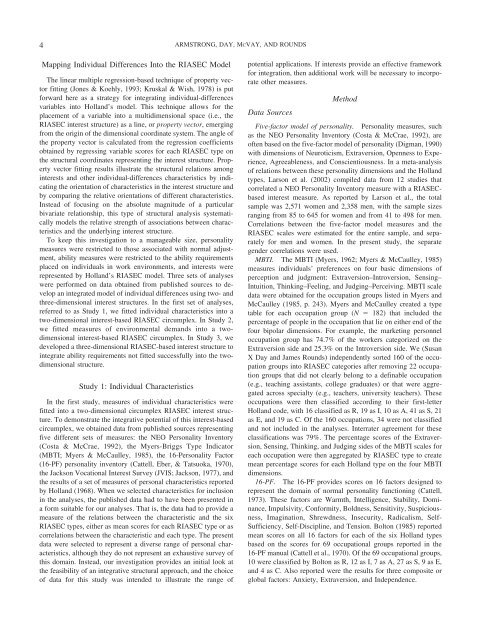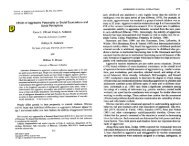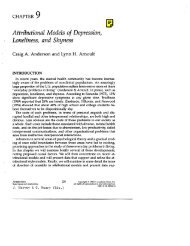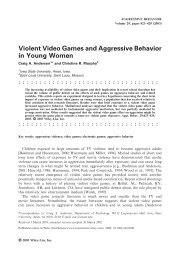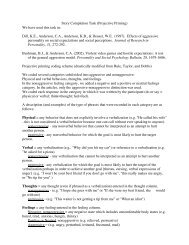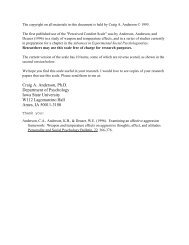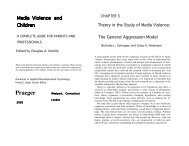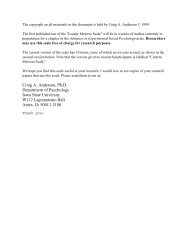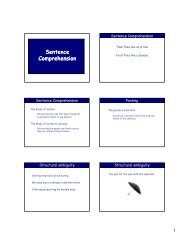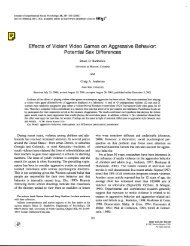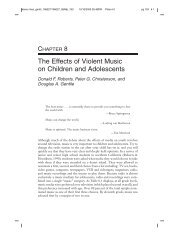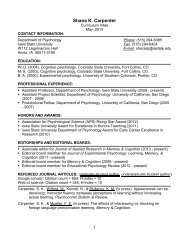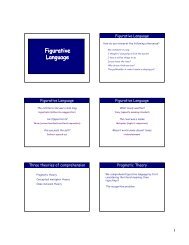Holland's RIASEC Model as an Integrative Framework for Individual ...
Holland's RIASEC Model as an Integrative Framework for Individual ...
Holland's RIASEC Model as an Integrative Framework for Individual ...
You also want an ePaper? Increase the reach of your titles
YUMPU automatically turns print PDFs into web optimized ePapers that Google loves.
4 ARMSTRONG, DAY, MCVAY, AND ROUNDS<br />
Mapping <strong>Individual</strong> Differences Into the <strong>RIASEC</strong> <strong>Model</strong><br />
The linear multiple regression-b<strong>as</strong>ed technique of property vector<br />
fitting (Jones & Koehly, 1993; Kruskal & Wish, 1978) is put<br />
<strong>for</strong>ward here <strong>as</strong> a strategy <strong>for</strong> integrating individual-differences<br />
variables into Holl<strong>an</strong>d’s model. This technique allows <strong>for</strong> the<br />
placement of a variable into a multidimensional space (i.e., the<br />
<strong>RIASEC</strong> interest structure) <strong>as</strong> a line, or property vector, emerging<br />
from the origin of the dimensional coordinate system. The <strong>an</strong>gle of<br />
the property vector is calculated from the regression coefficients<br />
obtained by regressing variable scores <strong>for</strong> each <strong>RIASEC</strong> type on<br />
the structural coordinates representing the interest structure. Property<br />
vector fitting results illustrate the structural relations among<br />
interests <strong>an</strong>d other individual-differences characteristics by indicating<br />
the orientation of characteristics in the interest structure <strong>an</strong>d<br />
by comparing the relative orientations of different characteristics.<br />
Instead of focusing on the absolute magnitude of a particular<br />
bivariate relationship, this type of structural <strong>an</strong>alysis systematically<br />
models the relative strength of <strong>as</strong>sociations between characteristics<br />
<strong>an</strong>d the underlying interest structure.<br />
To keep this investigation to a m<strong>an</strong>ageable size, personality<br />
me<strong>as</strong>ures were restricted to those <strong>as</strong>sociated with normal adjustment,<br />
ability me<strong>as</strong>ures were restricted to the ability requirements<br />
placed on individuals in work environments, <strong>an</strong>d interests were<br />
represented by Holl<strong>an</strong>d’s <strong>RIASEC</strong> model. Three sets of <strong>an</strong>alyses<br />
were per<strong>for</strong>med on data obtained from published sources to develop<br />
<strong>an</strong> integrated model of individual differences using two- <strong>an</strong>d<br />
three-dimensional interest structures. In the first set of <strong>an</strong>alyses,<br />
referred to <strong>as</strong> Study 1, we fitted individual characteristics into a<br />
two-dimensional interest-b<strong>as</strong>ed <strong>RIASEC</strong> circumplex. In Study 2,<br />
we fitted me<strong>as</strong>ures of environmental dem<strong>an</strong>ds into a twodimensional<br />
interest-b<strong>as</strong>ed <strong>RIASEC</strong> circumplex. In Study 3, we<br />
developed a three-dimensional <strong>RIASEC</strong>-b<strong>as</strong>ed interest structure to<br />
integrate ability requirements not fitted successfully into the twodimensional<br />
structure.<br />
Study 1: <strong>Individual</strong> Characteristics<br />
In the first study, me<strong>as</strong>ures of individual characteristics were<br />
fitted into a two-dimensional circumplex <strong>RIASEC</strong> interest structure.<br />
To demonstrate the integrative potential of this interest-b<strong>as</strong>ed<br />
circumplex, we obtained data from published sources representing<br />
five different sets of me<strong>as</strong>ures: the NEO Personality Inventory<br />
(Costa & McCrae, 1992), the Myers-Briggs Type Indicator<br />
(MBTI; Myers & McCaulley, 1985), the 16-Personality Factor<br />
(16-PF) personality inventory (Cattell, Eber, & Tatsuoka, 1970),<br />
the Jackson Vocational Interest Survey (JVIS; Jackson, 1977), <strong>an</strong>d<br />
the results of a set of me<strong>as</strong>ures of personal characteristics reported<br />
by Holl<strong>an</strong>d (1968). When we selected characteristics <strong>for</strong> inclusion<br />
in the <strong>an</strong>alyses, the published data had to have been presented in<br />
a <strong>for</strong>m suitable <strong>for</strong> our <strong>an</strong>alyses. That is, the data had to provide a<br />
me<strong>as</strong>ure of the relations between the characteristic <strong>an</strong>d the six<br />
<strong>RIASEC</strong> types, either <strong>as</strong> me<strong>an</strong> scores <strong>for</strong> each <strong>RIASEC</strong> type or <strong>as</strong><br />
correlations between the characteristic <strong>an</strong>d each type. The present<br />
data were selected to represent a diverse r<strong>an</strong>ge of personal characteristics,<br />
although they do not represent <strong>an</strong> exhaustive survey of<br />
this domain. Instead, our investigation provides <strong>an</strong> initial look at<br />
the fe<strong>as</strong>ibility of <strong>an</strong> integrative structural approach, <strong>an</strong>d the choice<br />
of data <strong>for</strong> this study w<strong>as</strong> intended to illustrate the r<strong>an</strong>ge of<br />
potential applications. If interests provide <strong>an</strong> effective framework<br />
<strong>for</strong> integration, then additional work will be necessary to incorporate<br />
other me<strong>as</strong>ures.<br />
Data Sources<br />
Method<br />
Five-factor model of personality. Personality me<strong>as</strong>ures, such<br />
<strong>as</strong> the NEO Personality Inventory (Costa & McCrae, 1992), are<br />
often b<strong>as</strong>ed on the five-factor model of personality (Digm<strong>an</strong>, 1990)<br />
with dimensions of Neuroticism, Extraversion, Openness to Experience,<br />
Agreeableness, <strong>an</strong>d Conscientiousness. In a meta-<strong>an</strong>alysis<br />
of relations between these personality dimensions <strong>an</strong>d the Holl<strong>an</strong>d<br />
types, Larson et al. (2002) compiled data from 12 studies that<br />
correlated a NEO Personality Inventory me<strong>as</strong>ure with a <strong>RIASEC</strong>b<strong>as</strong>ed<br />
interest me<strong>as</strong>ure. As reported by Larson et al., the total<br />
sample w<strong>as</strong> 2,571 women <strong>an</strong>d 2,358 men, with the sample sizes<br />
r<strong>an</strong>ging from 85 to 645 <strong>for</strong> women <strong>an</strong>d from 41 to 498 <strong>for</strong> men.<br />
Correlations between the five-factor model me<strong>as</strong>ures <strong>an</strong>d the<br />
<strong>RIASEC</strong> scales were estimated <strong>for</strong> the entire sample, <strong>an</strong>d separately<br />
<strong>for</strong> men <strong>an</strong>d women. In the present study, the separate<br />
gender correlations were used.<br />
MBTI. The MBTI (Myers, 1962; Myers & McCaulley, 1985)<br />
me<strong>as</strong>ures individuals’ preferences on four b<strong>as</strong>ic dimensions of<br />
perception <strong>an</strong>d judgment: Extraversion–Introversion, Sensing–<br />
Intuition, Thinking–Feeling, <strong>an</strong>d Judging–Perceiving. MBTI scale<br />
data were obtained <strong>for</strong> the occupation groups listed in Myers <strong>an</strong>d<br />
McCaulley (1985, p. 243). Myers <strong>an</strong>d McCaulley created a type<br />
table <strong>for</strong> each occupation group (N 182) that included the<br />
percentage of people in the occupation that lie on either end of the<br />
four bipolar dimensions. For example, the marketing personnel<br />
occupation group h<strong>as</strong> 74.7% of the workers categorized on the<br />
Extraversion side <strong>an</strong>d 25.3% on the Introversion side. We (Sus<strong>an</strong><br />
X Day <strong>an</strong>d James Rounds) independently sorted 160 of the occupation<br />
groups into <strong>RIASEC</strong> categories after removing 22 occupation<br />
groups that did not clearly belong to a definable occupation<br />
(e.g., teaching <strong>as</strong>sist<strong>an</strong>ts, college graduates) or that were aggregated<br />
across specialty (e.g., teachers, university teachers). These<br />
occupations were then cl<strong>as</strong>sified according to their first-letter<br />
Holl<strong>an</strong>d code, with 16 cl<strong>as</strong>sified <strong>as</strong> R, 19 <strong>as</strong> I, 10 <strong>as</strong> A, 41 <strong>as</strong> S, 21<br />
<strong>as</strong> E, <strong>an</strong>d 19 <strong>as</strong> C. Of the 160 occupations, 34 were not cl<strong>as</strong>sified<br />
<strong>an</strong>d not included in the <strong>an</strong>alyses. Interrater agreement <strong>for</strong> these<br />
cl<strong>as</strong>sifications w<strong>as</strong> 79%. The percentage scores of the Extraversion,<br />
Sensing, Thinking, <strong>an</strong>d Judging sides of the MBTI scales <strong>for</strong><br />
each occupation were then aggregated by <strong>RIASEC</strong> type to create<br />
me<strong>an</strong> percentage scores <strong>for</strong> each Holl<strong>an</strong>d type on the four MBTI<br />
dimensions.<br />
16-PF. The 16-PF provides scores on 16 factors designed to<br />
represent the domain of normal personality functioning (Cattell,<br />
1973). These factors are Warmth, Intelligence, Stability, Domin<strong>an</strong>ce,<br />
Impulsivity, Con<strong>for</strong>mity, Boldness, Sensitivity, Suspiciousness,<br />
Imagination, Shrewdness, Insecurity, Radicalism, Self-<br />
Sufficiency, Self-Discipline, <strong>an</strong>d Tension. Bolton (1985) reported<br />
me<strong>an</strong> scores on all 16 factors <strong>for</strong> each of the six Holl<strong>an</strong>d types<br />
b<strong>as</strong>ed on the scores <strong>for</strong> 69 occupational groups reported in the<br />
16-PF m<strong>an</strong>ual (Cattell et al., 1970). Of the 69 occupational groups,<br />
10 were cl<strong>as</strong>sified by Bolton <strong>as</strong> R, 12 <strong>as</strong> I, 7 <strong>as</strong> A, 27 <strong>as</strong> S, 9 <strong>as</strong> E,<br />
<strong>an</strong>d 4 <strong>as</strong> C. Also reported were the results <strong>for</strong> three composite or<br />
global factors: Anxiety, Extraversion, <strong>an</strong>d Independence.


